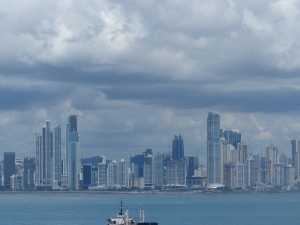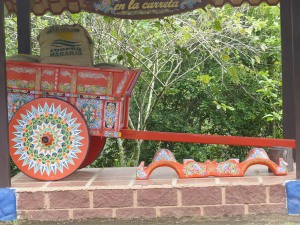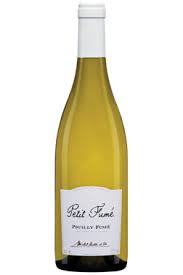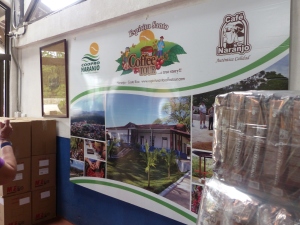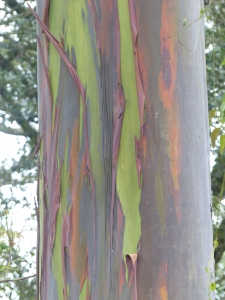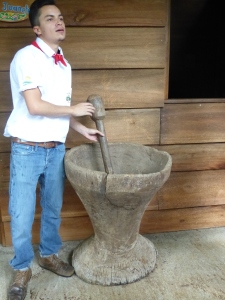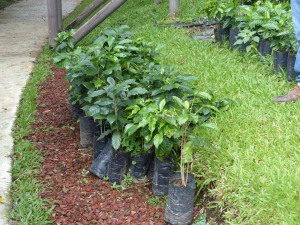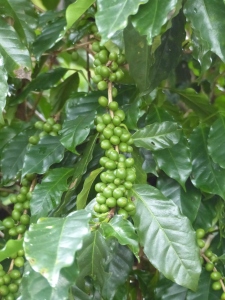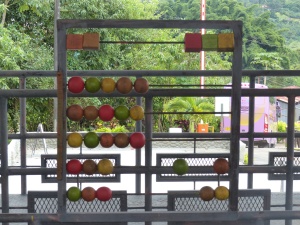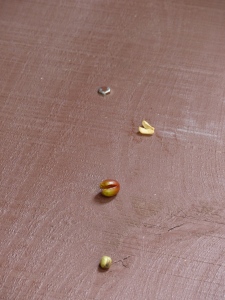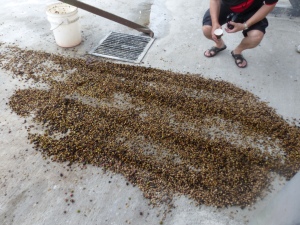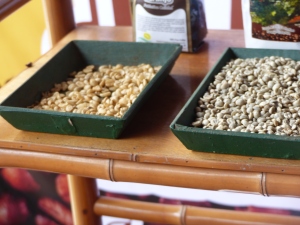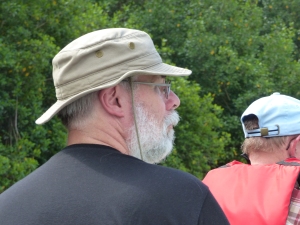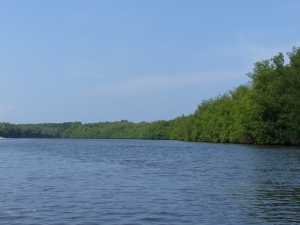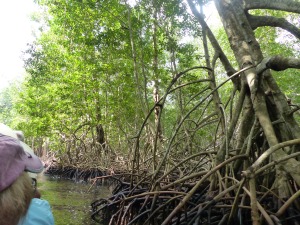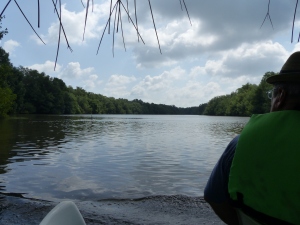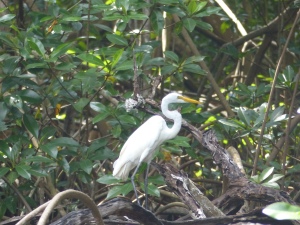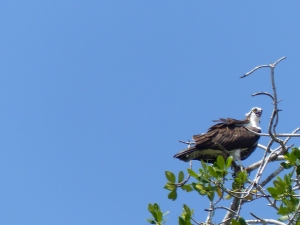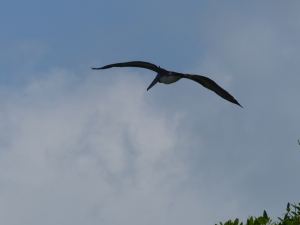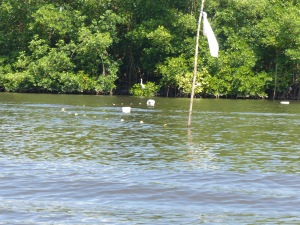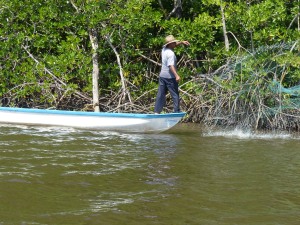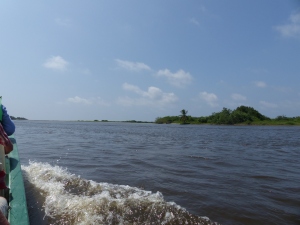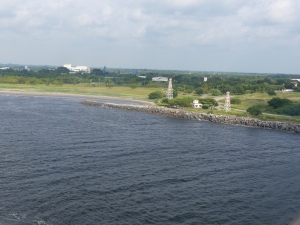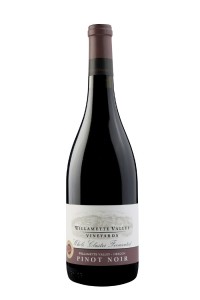We arrive in Puntarenas at 8 am, thereby confusing brain fogged me again. I thought we were headed for Puerto Calderas, but apparently something changed and instead we landed in a place called Puntarenas.
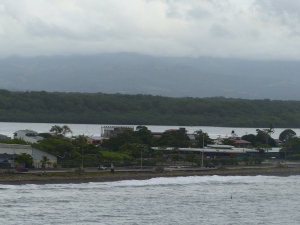
It seems that Puntarenas and Puerto Caldera are two major ports on the Pacific side of the country – they’re very close and Puerto Caldera is the container port – where all the exports and import products come and go. Puntarenas is a city, long and narrow, and dedicated to shipping, fishing (commercial and tourist/recreational) and tourism.
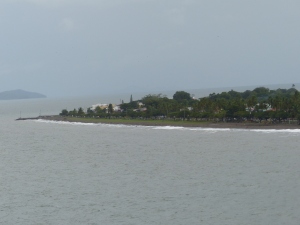
We land in whichever one has room, and if both do, then by choice, Puntarenas. The port has far less visible military and police presence than any of the Mexican ports we were in.

Part of this is because Costa Rica doesn’t have a military. In 1948, they did away with it, and applied the 25% budget apportionment to education, health and social services. Canada, the US and Great Britain provide protection for them. France, Italy, and one or two other countries voluntarily joined the group later. Canada and the US provide coast guard patrols, although we didn’t see any naval vessels at all in the port or on the approach.
We’re going on another long excursion, this one to a coffee plantation in the interior of Costa Rica. The excursion was an hour and a half ride up to Espiritu Santo (Holy Spirit) Coffee Plantation Cooperative with a stop at an artisan’s outlet and was designed to give us some information about Costa Rica in general, as well as show us a coffee plantation.
The people of Costa Rica are, like Canadians and Americans, immigrants from elsewhere. The indigenous people are no longer the majority of the population and have been moved from their original homes in the centre of the country to the coastal regions. We were told on board ship that the coastal regions were populated by immigrants, and that the cities there seemed more threatening because of that, but if we were to go inland, we’d meet the “real” Costa Ricans. I’m assuming they meant that the coastal regions, are being populated by recent immigrants from South America, since our tour guide, Francisco, told us that his Italian grandparents settled here just after World War II, and his wife is Chinese.
A good proportion of the people we saw looked less Central American/Mexican than they did Russian, German, British, Spanish, Italian, French, Afro-Caribbean and Asian.
Costa Rica is a democratic republic, but with leftist leanings. Education, including university, is state supported, medical care is state supported, they have an excellent infrastructure of roads and electricity – even the poorest houses we saw had power and usually, TV antennas or satellite dishes and cars or motorcycles.
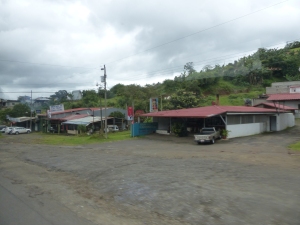 I’ve seen towns like this in BC and Washington State.
I’ve seen towns like this in BC and Washington State.
Their senior citizens have some amazing benefits, including free public transit both within and between cities and towns (which includes a traveling companion, regardless of age). They’re welcoming just about anybody into their country, and are dedicated to equal rights for all (whether this included the Indian population and women, I’m not sure.) In order to receive all the same rights and benefits of a Costa Rican citizen, you basically have to open a bank account, keep it open for six months and show an address that’s somewhere in Costa Rica. Their unemployment rate is 4%.
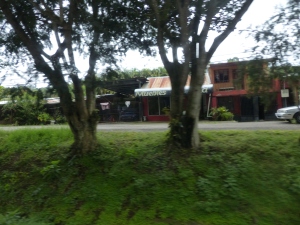 Looks so much like home, I want to move in!
Looks so much like home, I want to move in!
What they don’t have is a welfare state. You don’t work, you don’t eat. Unless you’re a wife who’s been deserted, and even then, you get a roof over your head and the government makes damn sure your ex-partner pays half of his earnings as support, but anything over that you have to go out and work for. But the idea of welfare because you’re unemployable doesn’t seem to exist. I don’t know if that extends to medical disability or not.
What they do have is a fierce taxation system. Income tax is 9% across the board, but sales and services taxes can be up to 30% – but it seems to be working. People pay it because they get the services – free education and health care, low cost electricity (state owned and run) of around $50.00 a month, low cost water ($5.00 a month), and well maintained (or as well as can be in a tropical rain forest and earthquake prone zone) roads. The phone system is user pay.
They’re dedicated to an ecologically advanced state that is concerned with sustainability and preservation of the environment, while trying to balance employment and industry at the same time. I don’t know how successful they are, but they’re definitely dedicated to protecting the environment in several areas. But they are also trying to diversify their economy, so they have a major interest in the manufacture of microchips and call centres (Francisco, our tour guide, told us about phoning the Amazon call centre for some reason, and confusing the telephone operator when he spoke to her in Spanish and then told her her work place was only five blocks from his house). They grow coffee, tobacco, pineapples, bananas (Costa Rica is apparently the origin of the term “banana republic”), dairy production (including buffalo dairy and meat), mangos and mangas (if you want what we call a mango at home, in CR, you have to ask for a manga – mangoes are extremely bitter and eaten the way tequila is drunk: lemon and salt on thin slices.) They have an exporting fishing industry and a massive tuna factory – if you’ve ever heard of Bumblebee Tuna (I hadn’t), then that’s where it’s caught, processed and packed. Tourism is their fourth largest industry, after the microchips, call centres and coffee.
We saw a huge variety of housing on the trip – poor houses, made of scrounged material, with corrugated tin roofs and sometimes walls, yes, but also small, neatly made and kept row houses, and what I’d term middle class and upper middle class houses – lawns, driveways, neatly kept extensive gardens.
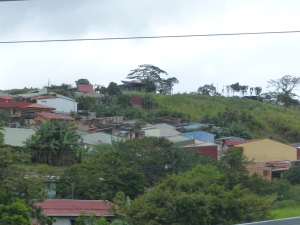
More of the latter – working class and middle class – than the absolute poorest. Everybody had a garden – even the poorest and smallest houses had plants in pots and a tree or two in the courtyard, and even the poorest houses had fences and gates and bars on the windows.
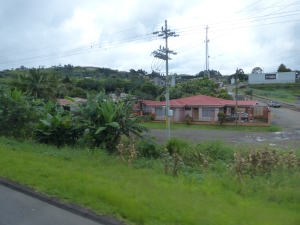 (That’s as much to keep curious critters out as it is to keep unwelcome people out – although the barbed wire and the glass topped walls I suspect were for the human critters. Nasty looking stuff, and not just on government property and commercial and industrial property. I saw a lot of it on residential places too.)
(That’s as much to keep curious critters out as it is to keep unwelcome people out – although the barbed wire and the glass topped walls I suspect were for the human critters. Nasty looking stuff, and not just on government property and commercial and industrial property. I saw a lot of it on residential places too.)
The cities and towns had lots and lots of scrub growth, and the villages were fighting a constant battle against the forest. (So were the towns: stuff here is growing in a lush, wet, warm climate on amazingly rich volcanic soil. The problem isn’t growing things, it’s trying to stop the growth from taking over).
Costa Rica is, we were informed, on the tectonic break between North and South America – it straddles the plates, and we apparently passed the break point on the way to the plantation (I’m taking the guide’s word for it – I wouldn’t know.) (Later addition: I did some research on arriving home. He’s right – Costa Rica is on a fault, but it’s not the the one that divides North and South America – that doesn’t exist. There’s about three plates that converge either on Costa Rican soil or right next to it. Costa Rica is on the Caribbean plate and the North American plate. The Cocos plate butts up against both of them just off the Pacific coast). Because of this, earthquakes are a daily occurrence in the country, and consequently, buildings tend to be low and single story – two or three at most. Buildings are cement by and large, with big window spaces and cooling vents under every roofline. Gutters, interestingly, are attached to the houses in two ways – the usual manner and with extra support nailed to the roof. When it rains, during the rainy season, it doesn’t kid around.
The center of the country is mountainous, with either two or three ranges running down the middle of the nation. North and south the land tends to flatten out, also to east and west – the Pacific and the Caribbean. Most of the agriculture is in the central part of the country and that’s where we went to see the plantation.
They have the same problem that North America does in terms of its agricultural workforce. A generation ago, most of the agricultural workers were Costa Ricans. During coffee harvesting especially, it was the pattern for families to move from the city to the country and spend the harvest picking berries – at that time, a 26 pound basket earned $1. Francisco said that as a kid, that’s how he used to earn his Christmas money – picking coffee during November and December. Like us, their “summer” holidays coincide with the harvest – so school doesn’t start until February and stops at the end of October, which is when the coffee harvest begins. Entire families did it as a seasonal job. But with the advent of education (so said our guide), nobody wants to do it anymore, and so they have to import workers from Nicaragua, where they get paid twice what they earn in their home country. (The rate is now $2.00 a basket, and one worker can harvest up to 20 to 25 baskets a day. Families pick together and between them can earn hundreds of dollars a day if they combine wages). The plantations provide housing, water and power, so the migrant workers only have to pay for food and whatever entertainment they choose while they’re picking.
How true is all this? I have to admit, it sounded a bit rah-rah – after all, no place is free of problems and social issues, but I know, independently, that recently and for a couple of years, Costa Rica has been rated by a couple of international organizations as on of the best places to live on the planet. So obviously, despite whatever problems they do have, they’re doing something very right.
Tomorrow, we get to the plantation and learn about how coffee is made. Advance note: one of the best things about the plantation is that the tours are definitely a sideline – they make their money by growing and selling coffee – we’re just the icing on the cake, which feels a lot better than knowing somebody’s rent money rests on whether I buy their goods or not.
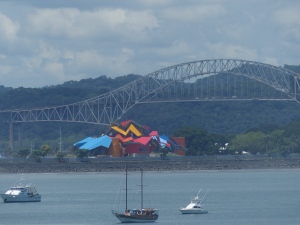 Part of the causeway – the bright coloured circus tent like thing is the Bridge of Life Museum of Biodiversity.
Part of the causeway – the bright coloured circus tent like thing is the Bridge of Life Museum of Biodiversity.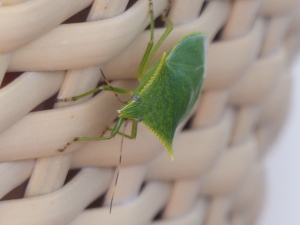 And just because I got the photo – a visitor from the mainland.
And just because I got the photo – a visitor from the mainland.
